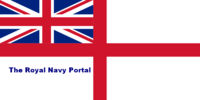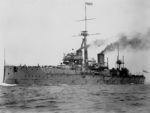- Portal:Royal Navy
-
 American Civil War · American Revolutionary War · Battleships ·
American Civil War · American Revolutionary War · Battleships ·  Biological warfare · British Army · Canadian Forces · Cold War · Crusades ·
Biological warfare · British Army · Canadian Forces · Cold War · Crusades ·  Italian Wars · Military history of Africa · Military history of France · Military history of the Ottoman Empire · Military of ancient Rome ·
Italian Wars · Military history of Africa · Military history of France · Military history of the Ottoman Empire · Military of ancient Rome ·  Military of Australia · Military of Germany ·
Military of Australia · Military of Germany ·  Military of Greece · Military of Pakistan ·
Military of Greece · Military of Pakistan ·  Military of the United States ·
Military of the United States ·  Napoleonic Wars · NATO · Royal Air Force · Royal Navy · Submarine · Tank ·
Napoleonic Wars · NATO · Royal Air Force · Royal Navy · Submarine · Tank ·  Terrorism ·
Terrorism ·  United States Air Force · United States Army · United States Coast Guard · United States Marine Corps ·
United States Air Force · United States Army · United States Coast Guard · United States Marine Corps ·  United States Navy ·
United States Navy ·  War · War of 1812 · Weapons of mass destruction ·
War · War of 1812 · Weapons of mass destruction ·  World War I ·
World War I ·  World War II
World War II
The Royal Navy of the United Kingdom is the oldest of the British armed services (and is therefore the Senior Service). From the early 18th century to the middle of the 20th century, it was the largest and most powerful navy in the world, playing a key part in establishing the British Empire as the dominant power of the 19th and early 20th centuries. In WWII, the Royal Navy operated almost 600 ships. During the Cold War, it was transformed into a primarily anti-submarine force, hunting for Soviet submarines, mostly active in the North Atlantic Ocean. With the collapse of the Soviet Union, its role for the 21st century has returned to focus on global expeditionary (blue water) operations.
The Royal Navy is the second-largest navy in NATO in terms of the combined tonnage of its fleet. Its global power projection capabilities are deemed second only to the United States Navy. There are currently 91 commissioned ships in the Royal Navy, including aircraft carriers, submarines, mine counter-measures and patrol vessels. There are also the support vessels of the Royal Fleet Auxiliary.
The Royal Navy is a constituent component of the Naval Service, which also comprises the Royal Marines, Royal Fleet Auxiliary and associated reserve forces under command. The Naval Service had 38,710 regular personnel as of November 2006.
Selected battle
The Battle of the North Cape, was a naval battle of World War II that occurred on December 26, 1943. Ships of the Royal Navy engaged and sank the German battlecruiser Scharnhorst off Norway's North Cape. The outcome of the battle demonstrated the vital importance of radar in modern naval warfare. While the Scharnhorst outgunned her opponents - with the exception of HMS Duke of York - the early loss of radar-assisted fire control combined with the problem of inclement weather left her at a significant disadvantage. The battle was the last significant engagement of the Atlantic Campaign, and essentially ended the threat posed by German surface ships.
The battle may also be the northernmost in the history of naval warfare.
Selected ship
The sixth HMS Dreadnought of the Royal Navy was a revolutionary battleship which entered service in 1906. So advanced was Dreadnought that her name became a generic term for modern battleships, whilst the ships she made obsolete became known as "pre-dreadnoughts". Her introduction helped spark off a major naval arms race as navies around the world rushed to match her, particularly the German navy in the build up to the First World War. Dreadnought was the first battleship of her era to have a uniform main battery, rather than having a few large guns complemented by a heavy secondary battery of somewhat smaller guns. She was also the first major warship to be powered by steam turbines, making her the fastest battleship in the world at the time of her completion.
Categories
[×] Royal Navy listsSelected picture
A UGM-27 Polaris submarine-launched ballistic missile is launched from the British submarine HMS Revenge (S27).
Original photograph is a public domain image produced by a US military or Department of Defense employee.Selected biography
Admiral of the Fleet John Arbuthnot "Jackie" Fisher, 1st Baron Fisher of Kilverstone, GCB, OM, GCVO (25 January 1841 – 10 July 1920) was a British admiral known for his efforts at naval reform. He had a huge influence on the Royal Navy in a career spanning more than 60 years, starting in a navy of wooden sailing ships armed with muzzle-loading cannon and ending in one of battlecruisers, submarines and the first aircraft carriers. The argumentative, energetic, reform-minded Fisher is often considered the second most important figure of British naval history, after Lord Nelson.
Read more...
Did you know...
- ...that the HMS Finisterre replaced her sister ship, the Hogue, in Far Eastern service after the latter was destroyed by a collision with an Indian cruiser?
- ...that British Navy admiral Alexander Cochrane was responsible for the bombing of Fort McHenry, which inspired Francis Scott Key to write "The Star-Spangled Banner," which became the national anthem of the United States ?
- ...that the shipwreck of the HMS Orpheus was the biggest maritime disaster in New Zealand history?
- ...that Kenneth Cummins was one of the last 5 confirmed British surviving veterans of World War I , having served in the Royal and Merchant Navies in the First and Second World War respectively?
Major topics
Things you can do
From the Military history WikiProject:
Requested articles
Action of 11 August 1778 • Fawn class destroyer • Naval armament raceExpansion needed
Battle of the Atlantic (1939-1945) • British Pacific Fleet • British Eastern Fleet • Operation Ariel • Operation Neptune • Malta Convoys • Battle of Skerki BankFeatured content
 England expects that every man will do his duty
England expects that every man will do his duty List of Victoria Cross recipients of the Royal Navy
List of Victoria Cross recipients of the Royal Navy Order of battle at the Battle of Tory Island
Order of battle at the Battle of Tory IslandAssociated Wikimedia
- Wikipedia portals:
- Culture
- Geography
- Health
- History
- Mathematics
- Natural sciences
- People
- Philosophy
- Religion
- Society
- Technology
Categories:- Royal Navy
- Royal Navy portal
- History portals
- ...that the HMS Finisterre replaced her sister ship, the Hogue, in Far Eastern service after the latter was destroyed by a collision with an Indian cruiser?
Wikimedia Foundation. 2010.



